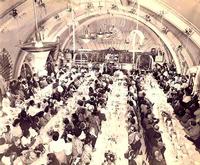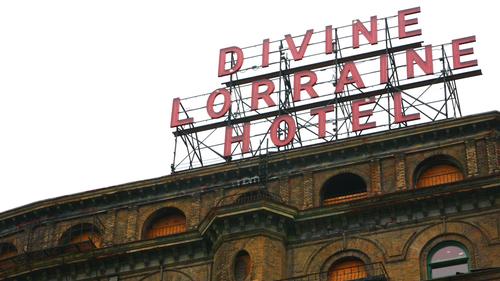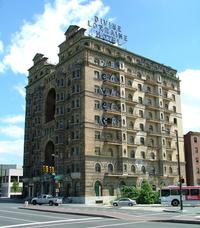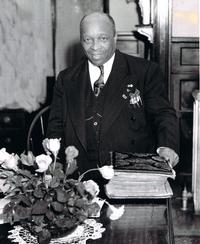A History Minute | Father Divine and the Behind the Scenes History of The Divine Lorraine Hotel
By Sally F.The Divine Lorraine's story is not just that of a dilapidated building brought back to glory before the wrecking ball's kiss, but a much more complicated, dramatic, and sometimes scandalous history than most Philadelphian's may know or remember. Read on to learn more about this truly interesting landmark and it's equally interesting backstory...
- The Divine Loraine was one of the first luxury high-rise apartment buildings in Philadelphia.
Built as The Lorraine Apartments in 1893, the building made use of new technologies to rise above the three- and four-story buildings that filled the city. The Lorraine’s 10 stories were supported by a steel framework and featured such luxuries as an elevator, electricity, on-site staff to care for tenants, and a central kitchen to deliver meals to each apartment. It housed newly wealthy industrialists whose factories fueled the city’s economy and provided jobs for thousands of residents.
- Architect Willis G. Hale designed The Lorraine, his second high-rise building.
Hale designed in the same flamboyant style as Frank Furness, in what has come to represent America’s Gilded Age. Hale was lauded as a visionary by fellow architects but critics referred to his style as a "restless jumble." Hale designed over 115 buildings in the Philadelphia area, including the lavish home of P.A.B. Widener at Broad and Girard. All but two of his high-rises have been demolished: the Divine Lorraine and the Hale Building at Chestnut and Juniper.
- The Metropolitan Hotel Company purchased the Lorraine Apartments in 1900
They renamed it the Lorraine Hotel, making it one of Philadelphia’s first luxury hotels.
- In 1948, Father Divine’s International Peace Mission Movement bought the Lorraine for $485,000 cash and renamed it The Divine Lorraine Hotel.
Under Father Divine’s leadership, it became the first racially integrated hotel in the U.S. Two years later, he purchased another hotel in West Philadephia and christened it the Divine Tracy.
- Father Major Jealous Divine was a self-named religious leader born in the South in the 1880s.
He established his Peace Mission in the 1920s on Long Island, but it was when he moved to Harlem in 1932 that it grew into a movement with an estimated 2 million+ members throughout the U.S. and as far away as Australia and Switzerland. Divine’s followers lived in residential hotels known as "heavens" and pooled their savings to start small businesses where members of the movement were employed. These businesses provided goods and services at low cost to the local community, enabling neighbors to survive the Depression while maintaining their dignity.
- Some consider Divine an early leader of the Civil Rights movement and the link between Marcus Garvey and Martin Luther King Jr.
In the 1940s and 1950s, before Martin Luther King and the Civil Rights Movement, Divine campaigned against lynching and was the first to propose a federal anti-lynching law. He commanded hundreds of thousands of followers to boycott businesses that refused to hire blacks. He used his white followers to stage sit-ins at white-only establishments and to buy property in white-only neighborhoods for use by his adherents.
- Every Peace Mission hosted weekly free banquets where hundreds of followers ate lavish meals while listening to Father Divine speak.
 The banquets and all of the mission’s residences and businesses were integrated. Father Divine believed that thinking racially perpetuated oppression. In fact, he did not permit the use of racial designations, but referred to people as dark or light complected.
The banquets and all of the mission’s residences and businesses were integrated. Father Divine believed that thinking racially perpetuated oppression. In fact, he did not permit the use of racial designations, but referred to people as dark or light complected.
-
Some consider Divine to be a charlatan who lived lavishly on his follower’s hard work.
Divine lived a lavish life with a fleet of Rolls-Royces, a custom made Duesenberg, expensive clothes, and elegant accommodations. There were reports of sexual abuse and mishandling of funds, but no evidence of this has ever surfaced. -
Father Divine preached the gospel of eternal life and believed himself to be the reincarnation of Jesus.
He told his followers that positive thinking and self-sufficiency would lead to prosperity on earth and that all people were equal in the sight of God. Divine did not believe in banks, credit, or insurance, and the Peace Mission and the hundreds of businesses it owned all operated on cash. Divine did not accept donations or remuneration for his spiritual activities. Followers did not accept welfare, Social Security, or tips. They gave all they owned to the movement and were supported by it for life. -
Father Divine required his followers to practice celibacy.
The hotels, both residential and public, followed the rules of the Mission. Men and women, even married couples, stayed on different floors and were only allowed to meet in the lobby or dining rooms. There was no smoking, drinking, or cursing. Women had to wear skirts of modest length and stockings. Men had to wear tucked-in shirts with sleeves and shoes with socks. Food and drink were not allowed in rooms and neither were televisions. -
Father Divine’s second wife, Sweet Angel, was a 21-year-old white woman, several decades younger than her new husband.
Divine claimed she was the reincarnation of his first wife, Sister Penny. Like Sister Penny, she was known to the followers as Mother Divine. The marriage was claimed to be celibate and representative of Christ’s marriage to the church.
-
Father and Mother Divine lived in Woodmont, a 72-acre estate in Gladwyne donated by a follower.
Woodmont is now the Peace Mission’s headquarters and is maintained by a handful of aging members. Father Divine was buried there after his death in 1963 and Mother Divine joined him in 2017. The manor, library, and museum are open to the public weekly, free of charge, no donations accepted. -
After Father Divine’s death, a former disciple--Jim Jones--declared himself the reincarnation of Jesus and tried to take over the organization.
When he was refused, he moved to California and founded the Peoples Temple. He later moved the cult to Jonestown, Guyana. In 1978, Jones led 909 members to commit suicide, in what would become the largest mass suicide in modern history.
-
Developer Eric Blumenthal bought The Divine Lorraine Hotel in 2015.
The building had been vacant since its closure in 1999. It had been stripped of fixtures, copper, anything of value, and covered in graffiti. Blumenthal has restored and renovated the building and rented several of the unique apartments. He has plans for restaurants and stores on the ground level.
-
The Divine Tracy was sold in 2006
It is now The Axis, which offers furnished apartments suitable for student housing.
Additional Resources:
Reading
Father Divine by Robert Weisbrot
Father Divine and the Struggle for Racial Equality by Robert Weisbrot
Listen
Father Divine Speaks, 15 May, 1951
Watch
Father Divine: A Case Study in Charisma by Leo Levy
Father's Kingdom (2017)
Have a question for Free Library staff? Please submit it to our Ask a Librarian page and receive a response within two business days.



